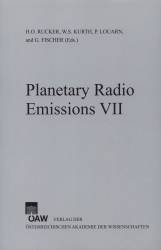
Planetary Radio Emissions VII, pp. 487-494, 2011/12/28
Proceedings of the 7th International Workshop on Planetary, Solar and Heliospheric Radio Emissions held at Graz, Austria, September 15–17, 2010

The high-frequency electric sensors onboard Solar Orbiter are part of the radio and plasma wave experiment (RPW). The sensors consist of cylindrical antennas (ANT) mounted on three booms extruded from the central body of the spacecraft. Due to the parasitic effects of the conducting spacecraft body and solar panels the true antenna properties (effective axes and length, capacitances) do not coincide with their physical representations. The numerical analysis of the reception properties of these antennas is presented. In order to analyze the antenna system we applied a numerical method. The current distribution on the spacecraft body and the effective length vector was calculated, by solving the underlying field equations using electromagnetic code. In the applied method the spacecraft is modeled as a mesh-grid.